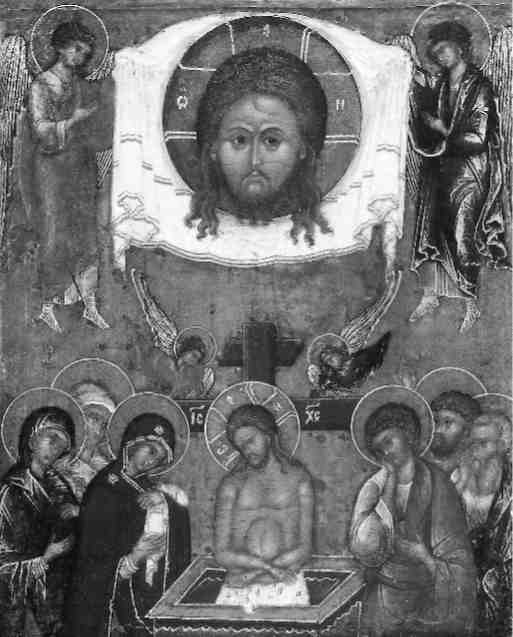‘Domestic Orthodoxy’, then, consists not in a rejection of the material world, but in the notion of a fusion of the material and the spiritual as the ideal. In this it has something in common with another salutary response to the cliches of other-worldliness, the construction of a theology of the body. The origins of this can be traced back to some writers associated with the national-conservative Slavophile movement. In Tolstoy’s eulogies of procreative family life in

20. ‘Don’t Weep for Me, Mother’: The Saviour not Made by Human Hands with Saints. Icon for Holy Week: a Muscovite version of the Greek
Rozanov, created a world where there was no separation between body and spirit, flesh and intellect. As the scholar Stephen Hutchings has pointed out, Rozanov’s was an existence where ‘the most exaggeratedly profound formulations are arrived at “over a cup of tea” or “in the lavatory”’. The writer firmly believed that ‘a hole in a sock that never grows larger, and never gets darned’ was a better expression of everlasting life than ‘the dry and abstract term “immortality of the soul” ’, and believed sexuality was an essential, indeed perhaps the essential, form of spiritual expression. In his
A similar attempt to embrace the bodily world is evident in one of the most enlivening and vivid responses to Socialist Realism, Mikhail Bakhtin’s study of Francois Rabelais, which celebrated the physicality of the ‘carnival’, glorifying the temporary suspension of rational decorum and the resurgence of ‘the lower bodily stratum’. Bakhtin’s concept of the carnival drew on a great deal more than the actual practices of fairgrounds and folk festivals, though the fashion for circus and vaudeville in 1920s Soviet literature, theatre, and film was definitely part of the background to the book. Rather, the evocation of the medieval carnival was used to create an imaginative space with many kinds of cultural resonance. Among these are the Stalin regime’s own promotion of a decorous and conformist kind of carnival, the Symbolists’ fascination with Dionysiac religion, in which the body of the god was repeatedly destroyed and repeatedly made whole, and popular traditions about lands of plenty and joy beyond the known world (as evoked also in Aleksandr Chayanov’s
In the act of eating, as we have said, the confines between the body and the world are overstepped by the body. It triumphs over the world, over its enemy, celebrates its victory, grows at the world’s expense. This element of victory and triumph is inherent in all banquet images. No meal can be sad. Sadness and food are incompatible (while death and food are perfectly compatible). The banquet always celebrates a victory and this is part of its very nature. Further, the triumphant banquet is always universal. It is the triumph of life over death. In this respect it is equivalent to conception and birth. The victorious body receives the defeated world and is renewed.
(Chapter 4)
Popular feasting and the Christian Eucharist, with its link to resurrection on the one hand and crucifixion on the other, come together in a tour-de-force of neo-Slavophile cultural criticism, which synthesizes rather than analyses and is rooted in a determination to celebrate the wholeness of life, and not to discriminate between ‘aesthetic’ and ‘anti-aesthetic’, acceptable and unacceptable, sensations.
Bakhtin’s book is also a tribute to the vitality of humour in Russian culture, as, too, are Rozanov’s miniatures, not only the vessels of ‘exaggerated profundity’ but of studiedly ridiculous self-portraits – having confiscated his children’s Sherlock Holmes stories as ‘harmful reading’, Rozanov devoured them himself at every possible opportunity, ‘so that the train journey from Siverskaya to St Petersburg flew past like a dream’. A popular Western view of Russia sees the place as grim, dank, and with permanently gloomy inhabitants given to fits of weeping and talking about their souls. No one could maintain this
illusion for long when reading Russian literature. In Chekhov’s plays, even characters prone to maudlin fits of self-pity display a talent for flights of black comedy (as when Uncle Vanya responds to a social banality about the nice weather with the words, ‘Nice weather to hang yourself in’). Here, humour is a weapon for exposing artificiality (as it also is in Dostoevsky’s novels, where lapses into absurdity threaten every carefully planned social event). But ridicule is often more universal than this, giving a sense of human existence as necessarily grotesque – as in the scene from Chekhov’s ‘Ward No. 6’ (1892) where one madman boasts of his fantasy service decorations to another invalided out of the civil service when he became wrongly convinced he was making mistakes and developed paranoia.
Black humour of this kind survived at even the darkest eras of history, such as the late 1930s. To be sure, in Socialist Realist texts, humour that was not of the unintentional sort was limited to crude jokes directed at a narrow range of social types (shirkers at work, women who used too much make-up, men who tried to lay down the law to their wives). In unofficial writing, though, a vivid and subtle feeling of the ridiculous survived, and pompous bureaucrats were its main targets (in Bulgakov’s

